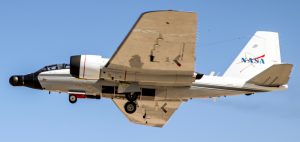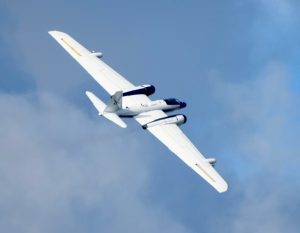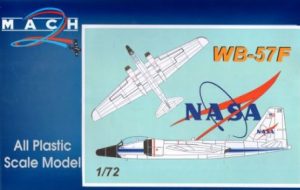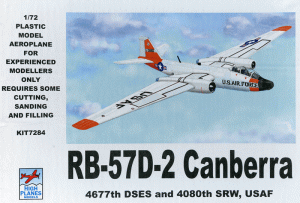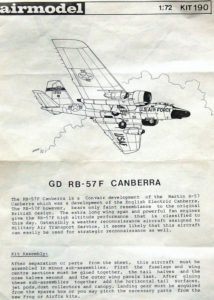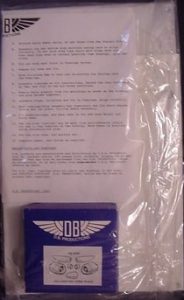Images of B-57B and WB-57F via NASA, USAF and USMC.
 This NASA B-57B was used to test the jet engine ‘mufflers’ (aka Hush Kits, officially Exhaust Noise Suppressors) that would be used on 1960s-early ’70s jet airliners. Dryden, Edwards AFB.
This NASA B-57B was used to test the jet engine ‘mufflers’ (aka Hush Kits, officially Exhaust Noise Suppressors) that would be used on 1960s-early ’70s jet airliners. Dryden, Edwards AFB.
 Wright J65-W-5 turbojets power the B-57B.
Wright J65-W-5 turbojets power the B-57B.
 Note the tail support rod, yes, even real jet aircraft used tail supports when parked for a long time. Also, the Hush Kits added a lot of weight to the rear of center-of-balance.
Note the tail support rod, yes, even real jet aircraft used tail supports when parked for a long time. Also, the Hush Kits added a lot of weight to the rear of center-of-balance.
 According to the information with this NASA photo the aircraft was painted in fluorescent colors, but it didn’t specify. They probably meant Day-Glo, which is the copyrighted name of the DayGlo Color Corporation.
According to the information with this NASA photo the aircraft was painted in fluorescent colors, but it didn’t specify. They probably meant Day-Glo, which is the copyrighted name of the DayGlo Color Corporation.
 09DEC1971, tail code 809 is bare metal with NASA markings and a ‘V’ under the cockpit. The V stood for Viking Mars Lander parachute test program.
09DEC1971, tail code 809 is bare metal with NASA markings and a ‘V’ under the cockpit. The V stood for Viking Mars Lander parachute test program.
 11 years later, tail code 809 in the standard white with blue stripes NASA colors. Wing tip pitots (both sides), different nose tip and pitot. In 1982, 809 began atmospheric research, everything from wind currents to air pollution.
11 years later, tail code 809 in the standard white with blue stripes NASA colors. Wing tip pitots (both sides), different nose tip and pitot. In 1982, 809 began atmospheric research, everything from wind currents to air pollution.
 809 was retired in 1987.
809 was retired in 1987.
USAF video report about the history of the B-57:

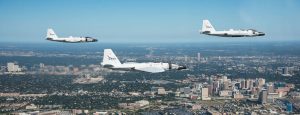 By 2015 only three B-57s were operating, all NASA WB-57Fs. The aircraft in the middle of the group is configured differently from the other two. (clicking on some of the smaller pics in this post will make them bigger)
By 2015 only three B-57s were operating, all NASA WB-57Fs. The aircraft in the middle of the group is configured differently from the other two. (clicking on some of the smaller pics in this post will make them bigger)
 The U.S. Air Force RB-57F was developed in the early 1960s to take air samples over enemy countries to determine if they had conducted nuclear bomb experiments. However, that was the secret mission, the official mission of RB-57Fs was weather forecasting. USAF RB-57Fs were plagued by engine problems and structural failures. The engines used are Pratt & Whitney TF33-P-11A turbofans. In 1968 RB-57Fs were re-designated WB-57F.
The U.S. Air Force RB-57F was developed in the early 1960s to take air samples over enemy countries to determine if they had conducted nuclear bomb experiments. However, that was the secret mission, the official mission of RB-57Fs was weather forecasting. USAF RB-57Fs were plagued by engine problems and structural failures. The engines used are Pratt & Whitney TF33-P-11A turbofans. In 1968 RB-57Fs were re-designated WB-57F.

This WB-57F has a modified foil covered nose carrying instruments to track a 2017 solar eclipse. Beginning in 1968 NASA began modifying WB-57Fs, code names Rivet Chip and Rivet Slice, for its specific high-altitude research. Every year the aircraft are modified with different sensors, and even new paint schemes, for the missions scheduled for that season of research.

 A NASA WB-57 takes off from the flight line of Marine Corps Air Station Miramar, California, 21AUG2019. The aircraft was utilizing the MCAS Miramar flight line and airspace to test new communications software.
A NASA WB-57 takes off from the flight line of Marine Corps Air Station Miramar, California, 21AUG2019. The aircraft was utilizing the MCAS Miramar flight line and airspace to test new communications software.





 In the rear seat (Robins AFB, Georgia), Don Darrow is about to take-off on a mission to track Hurricane Joaquin, in 2015.
In the rear seat (Robins AFB, Georgia), Don Darrow is about to take-off on a mission to track Hurricane Joaquin, in 2015.
 Spain, 2011, stop-over for routine maintenance and refueling.
Spain, 2011, stop-over for routine maintenance and refueling.


01JUL1979, then astronaut candidate Kathryn D. Sullivan set an unofficial altitude record in a NASA WB-57F; 63,300 feet was reached during a four-hour flight.
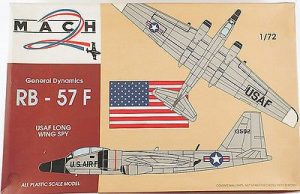 Mach2 issued two versions in 1:72 scale, the USAF RB-57 and the NASA WB-57F. They are not for beginners as they are low quality low pressure injection (short run) kits.
Mach2 issued two versions in 1:72 scale, the USAF RB-57 and the NASA WB-57F. They are not for beginners as they are low quality low pressure injection (short run) kits.
Airmodel made a RB-57F vacformed conversion for the old 1:72 scale Airfix or Frog Canberra kits.
DB Productions makes a vacformed and resin R/WB-57D/F conversion for 1:72 Italeri B-57B.
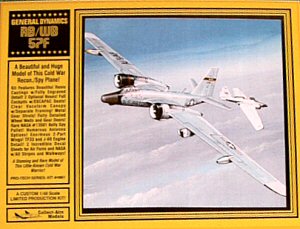 Collect-Aire Models made a 1:48 scale resin kit.
Collect-Aire Models made a 1:48 scale resin kit.
BARE METAL: NASA’S MD-11 EXPERIMENTAL
IDAHO, KANSAS, UTAH HOME BASES FOR NASA’S DC-8 FIREX-AQ!
NASA ‘CLIMATE SPY PLANE’ PROVES CALIFORNIA’S STRICT ANTI-POLLUTION LAWS ARE A JOKE!

